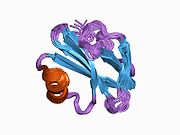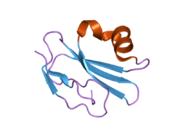CD59: Difference between revisions
Appearance
Content deleted Content added
m →Further reading: Added 1 doi to a journal cite using AWB (10213) |
No edit summary |
||
| Line 1: | Line 1: | ||
{{PBB|geneid=966}} |
{{PBB|geneid=966}} |
||
'''CD59 glycoprotein''' also known as '''MAC-inhibitory protein''' (MAC-IP), '''membrane inhibitor of reactive lysis''' (MIRL), or ''' |
'''CD59 glycoprotein''' also known as '''MAC-inhibitory protein''' (MAC-IP), '''membrane inhibitor of reactive lysis''' (MIRL), '''protectin''', or '''HRF''' is a [[protein]] that in humans is encoded by the ''CD59'' [[gene]].<ref>{{cite web |url=http://www.ncbi.nlm.nih.gov/entrez/query.fcgi?db=gene&cmd=retrieve&dopt=default&list_uids=966&rn=1 |title=Entrez Gene: CD59 molecule, complement regulatory protein}}</ref> |
||
CD59 attaches to host cells via a [[glycophosphatidylinositol]] (GPI) anchor. When [[Complement system|complement]] activation leads to deposition of C5b678 on host cells, CD59 can prevent [[complement component 9|C9]] from polymerizing and forming the [[complement membrane attack complex]].<ref name="pmid16844690">{{cite journal | author = Huang Y, Qiao F, Abagyan R, Hazard S, Tomlinson S | title = Defining the CD59-C9 binding interaction | journal = J. Biol. Chem. | volume = 281 | issue = 37 | pages = 27398–27404 | date=September 2006 | pmid = 16844690 | doi = 10.1074/jbc.M603690200 | url = }}</ref> Mutations affecting GPI that reduce expression of CD59 and [[decay-accelerating factor]] on [[red blood cell]]s result in [[paroxysmal nocturnal hemoglobinuria]].<ref name=parker2005>{{cite journal |author=Parker C, Omine M, Richards S, ''et al.'' |title=Diagnosis and management of paroxysmal nocturnal hemoglobinuria |journal=Blood |volume=106 |issue=12 |pages=3699–709 |year=2005 |pmid=16051736 |doi=10.1182/blood-2005-04-1717|url=http://bloodjournal.hematologylibrary.org/cgi/content/full/106/12/3699 | pmc=1895106}}</ref> |
CD59 attaches to host cells via a [[glycophosphatidylinositol]] (GPI) anchor. When [[Complement system|complement]] activation leads to deposition of C5b678 on host cells, CD59 can prevent [[complement component 9|C9]] from polymerizing and forming the [[complement membrane attack complex]].<ref name="pmid16844690">{{cite journal | author = Huang Y, Qiao F, Abagyan R, Hazard S, Tomlinson S | title = Defining the CD59-C9 binding interaction | journal = J. Biol. Chem. | volume = 281 | issue = 37 | pages = 27398–27404 | date=September 2006 | pmid = 16844690 | doi = 10.1074/jbc.M603690200 | url = }}</ref> Mutations affecting GPI that reduce expression of CD59 and [[decay-accelerating factor]] on [[red blood cell]]s result in [[paroxysmal nocturnal hemoglobinuria]].<ref name=parker2005>{{cite journal |author=Parker C, Omine M, Richards S, ''et al.'' |title=Diagnosis and management of paroxysmal nocturnal hemoglobinuria |journal=Blood |volume=106 |issue=12 |pages=3699–709 |year=2005 |pmid=16051736 |doi=10.1182/blood-2005-04-1717|url=http://bloodjournal.hematologylibrary.org/cgi/content/full/106/12/3699 | pmc=1895106}}</ref> |
||
Revision as of 19:11, 25 May 2014
Template:PBB CD59 glycoprotein also known as MAC-inhibitory protein (MAC-IP), membrane inhibitor of reactive lysis (MIRL), protectin, or HRF is a protein that in humans is encoded by the CD59 gene.[1]
CD59 attaches to host cells via a glycophosphatidylinositol (GPI) anchor. When complement activation leads to deposition of C5b678 on host cells, CD59 can prevent C9 from polymerizing and forming the complement membrane attack complex.[2] Mutations affecting GPI that reduce expression of CD59 and decay-accelerating factor on red blood cells result in paroxysmal nocturnal hemoglobinuria.[3]
Viruses such as HIV, human cytomegalovirus and vaccinia incorporate host cell CD59 into their own viral envelope to prevent lysis by complement.[4]
References
- ^ "Entrez Gene: CD59 molecule, complement regulatory protein".
- ^ Huang Y, Qiao F, Abagyan R, Hazard S, Tomlinson S (September 2006). "Defining the CD59-C9 binding interaction". J. Biol. Chem. 281 (37): 27398–27404. doi:10.1074/jbc.M603690200. PMID 16844690.
{{cite journal}}: CS1 maint: multiple names: authors list (link) CS1 maint: unflagged free DOI (link) - ^ Parker C, Omine M, Richards S; et al. (2005). "Diagnosis and management of paroxysmal nocturnal hemoglobinuria". Blood. 106 (12): 3699–709. doi:10.1182/blood-2005-04-1717. PMC 1895106. PMID 16051736.
{{cite journal}}: Explicit use of et al. in:|author=(help)CS1 maint: multiple names: authors list (link) - ^ Bohana-Kashtan O, Ziporen L, Donin N, Kraus S, Fishelson Z (July 2004). "Cell signals transduced by complement". Mol. Immunol. 41 (6–7): 583–597. doi:10.1016/j.molimm.2004.04.007. PMID 15219997.
{{cite journal}}: CS1 maint: multiple names: authors list (link)
Further reading
- Tandon N, Morgan BP, Weetman AP (1992). "Expression and function of membrane attack complex inhibitory proteins on thyroid follicular cells". Immunology. 75 (2): 372–7. PMC 1384722. PMID 1372592.
{{cite journal}}: CS1 maint: multiple names: authors list (link) - Holmes CH; Simpson KL; Okada H; et al. (1992). "Complement regulatory proteins at the feto-maternal interface during human placental development: distribution of CD59 by comparison with membrane cofactor protein (CD46) and decay accelerating factor (CD55)". Eur. J. Immunol. 22 (6): 1579–1585. doi:10.1002/eji.1830220635. PMID 1376264.
{{cite journal}}: Unknown parameter|author-separator=ignored (help) - Hahn WC; Menu E; Bothwell AL; et al. (1992). "Overlapping but nonidentical binding sites on CD2 for CD58 and a second ligand CD59". Science. 256 (5065): 1805–1807. doi:10.1126/science.1377404. PMID 1377404.
{{cite journal}}: Unknown parameter|author-separator=ignored (help) - Ninomiya H, Sims PJ (1992). "The human complement regulatory protein CD59 binds to the alpha-chain of C8 and to the "b"domain of C9". J. Biol. Chem. 267 (19): 13675–80. PMID 1377690.
- Petranka JG; Fleenor DE; Sykes K; et al. (1992). "Structure of the CD59-encoding gene: further evidence of a relationship to murine lymphocyte antigen Ly-6 protein". Proc. Natl. Acad. Sci. U.S.A. 89 (17): 7876–7879. doi:10.1073/pnas.89.17.7876. PMC 49817. PMID 1381503.
{{cite journal}}: Unknown parameter|author-separator=ignored (help) - Motoyama N, Okada N, Yamashina M, Okada H (1992). "Paroxysmal nocturnal hemoglobinuria due to hereditary nucleotide deletion in the HRF20 (CD59) gene". Eur. J. Immunol. 22 (10): 2669–2673. doi:10.1002/eji.1830221029. PMID 1382994.
{{cite journal}}: CS1 maint: multiple names: authors list (link) - Rooney IA, Morgan BP (1992). "Characterization of the membrane attack complex inhibitory protein CD59 antigen on human amniotic cells and in amniotic fluid". Immunology. 76 (4): 541–7. PMC 1421564. PMID 1383132.
- Tone M, Walsh LA, Waldmann H (1992). "Gene structure of human CD59 and demonstration that discrete mRNAs are generated by alternative polyadenylation". J. Mol. Biol. 227 (3): 971–976. doi:10.1016/0022-2836(92)90239-G. PMID 1383553.
{{cite journal}}: CS1 maint: multiple names: authors list (link) - Philbrick WM; Palfree RG; Maher SE; et al. (1990). "The CD59 antigen is a structural homologue of murine Ly-6 antigens but lacks interferon inducibility". Eur. J. Immunol. 20 (1): 87–92. doi:10.1002/eji.1830200113. PMID 1689664.
{{cite journal}}: Unknown parameter|author-separator=ignored (help) - Sawada R; Ohashi K; Anaguchi H; et al. (1990). "Isolation and expression of the full-length cDNA encoding CD59 antigen of human lymphocytes". DNA Cell Biol. 9 (3): 213–220. doi:10.1089/dna.1990.9.213. PMID 1692709.
{{cite journal}}: Unknown parameter|author-separator=ignored (help) - Yamashina M; Ueda E; Kinoshita T; et al. (1990). "Inherited complete deficiency of 20-kilodalton homologous restriction factor (CD59) as a cause of paroxysmal nocturnal hemoglobinuria". N. Engl. J. Med. 323 (17): 1184–1189. doi:10.1056/NEJM199010253231707. PMID 1699124.
{{cite journal}}: Unknown parameter|author-separator=ignored (help) - Rooney IA, Morgan BP (1991). "Protection of human amniotic epithelial cells (HAEC) from complement-mediated lysis: expression on the cells of three complement inhibitory membrane proteins". Immunology. 71 (3): 308–11. PMC 1384423. PMID 1702747.
- Watts MJ, Dankert JR, Morgan EP (1990). "Isolation and characterization of a membrane-attack-complex-inhibiting protein present in human serum and other biological fluids". Biochem. J. 265 (2): 471–7. PMC 1136908. PMID 2302178.
{{cite journal}}: CS1 maint: multiple names: authors list (link) - Okada H; Nagami Y; Takahashi K; et al. (1989). "20 KDa homologous restriction factor of complement resembles T cell activating protein". Biochem. Biophys. Res. Commun. 162 (3): 1553–1559. doi:10.1016/0006-291X(89)90852-8. PMID 2475111.
{{cite journal}}: Unknown parameter|author-separator=ignored (help) - Davies A; Simmons DL; Hale G; et al. (1989). "CD59, an LY-6-like protein expressed in human lymphoid cells, regulates the action of the complement membrane attack complex on homologous cells". J. Exp. Med. 170 (3): 637–654. doi:10.1084/jem.170.3.637. PMC 2189447. PMID 2475570.
{{cite journal}}: Unknown parameter|author-separator=ignored (help) - Sawada R; Ohashi K; Okano K; et al. (1989). "Complementary DNA sequence and deduced peptide sequence for CD59/MEM-43 antigen, the human homologue of murine lymphocyte antigen Ly-6C". Nucleic Acids Res. 17 (16): 6728–6728. doi:10.1093/nar/17.16.6728. PMC 318369. PMID 2476718.
{{cite journal}}: Unknown parameter|author-separator=ignored (help) - Sugita Y; Tobe T; Oda E; et al. (1990). "Molecular cloning and characterization of MACIF, an inhibitor of membrane channel formation of complement". J. Biochem. 106 (4): 555–7. PMID 2606909.
{{cite journal}}: Unknown parameter|author-separator=ignored (help) - Bora NS; Gobleman CL; Atkinson JP; et al. (1994). "Differential expression of the complement regulatory proteins in the human eye". Invest. Ophthalmol. Vis. Sci. 34 (13): 3579–84. PMID 7505007.
{{cite journal}}: Unknown parameter|author-separator=ignored (help) - Kieffer B; Driscoll PC; Campbell ID; et al. (1994). "Three-dimensional solution structure of the extracellular region of the complement regulatory protein CD59, a new cell-surface protein domain related to snake venom neurotoxins". Biochemistry. 33 (15): 4471–4482. doi:10.1021/bi00181a006. PMID 7512825.
{{cite journal}}: Unknown parameter|author-separator=ignored (help) - Kennedy SP; Rollins SA; Burton WV; et al. (1994). "Protection of porcine aortic endothelial cells from complement-mediated cell lysis and activation by recombinant human CD59". Transplantation. 57 (10): 1494–501. doi:10.1097/00007890-199405000-00017. PMID 7515200.
{{cite journal}}: Unknown parameter|author-separator=ignored (help)
External links
- CD59+Antigen at the U.S. National Library of Medicine Medical Subject Headings (MeSH)






